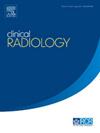Integrated clinical and imaging predictors of 60-day mortality in acute aortic dissection: emphasizing innominate and carotid artery involvement
IF 1.9
3区 医学
Q2 RADIOLOGY, NUCLEAR MEDICINE & MEDICAL IMAGING
引用次数: 0
Abstract
Objectives
To develop and validate a risk stratification model for 60-day mortality in acute aortic dissection by integrating computed tomography angiography and echocardiographic findings, with particular emphasis on aortic branch vessel involvement and surgical timing outcomes.
Methods
This retrospective cohort study analyzed 1,464 acute aortic dissection patients (development cohort) and two validation cohorts (temporal: n=340; geographical: n=421) between 2007-2019. Risk factors were assessed through CT angiography and echocardiography. Multivariable logistic regression and LASSO analyses identified independent predictors of 60-day mortality. Model performance was evaluated using AUC-ROC analysis and calibration plots.
Results
The 60-day mortality rate was 14.3% (210/1,464 patients). Independent predictors included age (adjusted OR 1.28, 95% CI 1.06–1.54), Stanford Type A (adjusted OR 1.85, 95% CI 1.42–2.41), innominate artery involvement (adjusted OR 1.45, 95% CI 1.15–1.83), left atrial enlargement (adjusted OR 1.32, 95% CI 1.04–1.67), and elevated FDP (adjusted OR 1.35, 95% CI 1.01–1.80). Combined risk factors showed the highest mortality, particularly pericardial effusion plus aortic regurgitation (42.3% in Type A). Mortality increased with delayed intervention from 15.2% (≤6 hours) to 35.8% (>24 hours) in Type A dissections. The model demonstrated robust performance in the temporal (AUC 0.77) and geographical (AUC 0.78) validation cohorts.
Conclusions
Integration of imaging parameters with clinical factors provides reliable mortality prediction in acute aortic dissection. Upper aortic branch involvement and cardiac imaging markers are significant predictors of mortality. Early intervention, particularly within 6 hours, is associated with improved survival. This risk stratification model may guide clinical decision-making regarding intervention timing and treatment strategy selection.
急性主动脉夹层60天死亡率的综合临床和影像学预测:强调无名动脉和颈动脉受累。
目的:通过整合计算机断层血管造影和超声心动图结果,建立并验证急性主动脉夹层60天死亡率的风险分层模型,特别强调主动脉分支血管受累情况和手术时机结果。方法:本回顾性队列研究分析了2007-2019年间1464例急性主动脉夹层患者(发展队列)和两个验证队列(时间:n=340;地理:n=421)。通过CT血管造影和超声心动图评估危险因素。多变量逻辑回归和LASSO分析确定了60天死亡率的独立预测因子。采用AUC-ROC分析和校正图评估模型性能。结果:60天死亡率为14.3%(210/ 1464)。独立预测因素包括年龄(校正OR 1.28, 95% CI 1.06-1.54)、Stanford A型血(校正OR 1.85, 95% CI 1.42-2.41)、无名动脉受累(校正OR 1.45, 95% CI 1.15-1.83)、左房扩大(校正OR 1.32, 95% CI 1.04-1.67)和FDP升高(校正OR 1.35, 95% CI 1.01-1.80)。综合危险因素显示死亡率最高,特别是心包积液加主动脉瓣反流(A型42.3%)。A型夹层延迟干预死亡率从15.2%(≤6小时)上升至35.8% (bbb24小时)。该模型在时间(AUC 0.77)和地理(AUC 0.78)验证队列中表现出稳健的性能。结论:影像参数与临床因素的结合可提供可靠的急性主动脉夹层死亡率预测。上主动脉分支受累和心脏影像学指标是死亡率的重要预测指标。早期干预,特别是在6小时内,可提高生存率。该风险分层模型可指导临床干预时机和治疗策略的选择。
本文章由计算机程序翻译,如有差异,请以英文原文为准。
求助全文
约1分钟内获得全文
求助全文
来源期刊

Clinical radiology
医学-核医学
CiteScore
4.70
自引率
3.80%
发文量
528
审稿时长
76 days
期刊介绍:
Clinical Radiology is published by Elsevier on behalf of The Royal College of Radiologists. Clinical Radiology is an International Journal bringing you original research, editorials and review articles on all aspects of diagnostic imaging, including:
• Computed tomography
• Magnetic resonance imaging
• Ultrasonography
• Digital radiology
• Interventional radiology
• Radiography
• Nuclear medicine
Papers on radiological protection, quality assurance, audit in radiology and matters relating to radiological training and education are also included. In addition, each issue contains correspondence, book reviews and notices of forthcoming events.
 求助内容:
求助内容: 应助结果提醒方式:
应助结果提醒方式:


